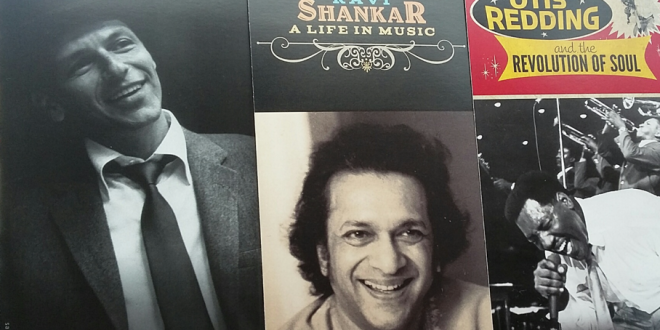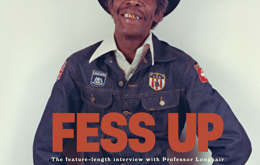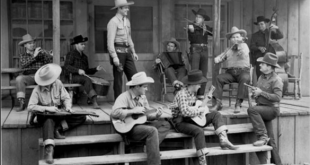Is it possible to be a music lover yet annually ignore the Grammys, second only to the Oscars in televised awards show viewership? Very possible: I love music and never watch, even when I’m told there are performances I would enjoy (this year’s was a tribute to B.B. King). The Grammys are a spectacle of marketing more than music. I’m glad that 25 million folk find the show entertaining enough to tune in, but my dim recollection of last seeing it is that it’s interminable, bombastic and I so rarely have a horse in the race that I could care less who wins, so why endure it? I don’t.
But the day after the 2016 Grammy show I found myself making a pilgrimage to downtown Los Angeles to the Grammy Museum. Why? Well, it was the final day of its exhibit, Sinatra: An American Icon, that’s why. Frank Sinatra was a singer I grew up with peripherally, a TV presence in that odd pantheon of official old folks’ show biz, a hazy realm inhabited by the then-stodgy likes of Ethel Merman and Bing Crosby. They would sing once-popular songs on huge soundstages with brassy orchestras, then embarrass themselves in silly skits that were rarely funny. It seemed dimly comprehensible to a kid, if uninteresting, and I’m not even sure my parents got it or liked it: I know they didn’t own any Sinatra records. I saw no fault in that: showing himself to be clueless, there were dumb photos of him `horsing around’ in a Beatles wig. Then, in a sad attempt to be `with it,’ he recorded a duet with his briefly hot daughter, Nancy, called “Something Stupid.” The song lived up to its name.
Having grown up with a Sinatra who was vaguely present but largely irrelevant, I became an adult in the age of Dark Frank, a surly old man who wrote nasty threats to any who questioned his greatness, surrounded himself with punch-prone thugs and had, some claimed, only the Mob to thank for his former success. There was the infamous Kitty Kelly bio (I didn’t care enough to read it), which Garry Trudeau hilariously `serialized’ in Doonesbury. The smiling avuncular tux-clad TV presence of my childhood morphed into a vile and reviled exemplar of hubris and hypocrisy.
But death and time work wonders. With the 21st century came Naugahyde nostalgia and fascination for the Sinatra-centric Rat Pack. Suddenly Sinatra ceased to be yesterday’s singing thug and morphed anew into a breezy embodiment of a hipness which dared to be square. A younger generation with no peripheral old-guy-who-doesn’t-get-it associations of `60s Sinatra embraced him in ways scarcely imaginable: in 2009 I attended a wedding performed by a minister from the Church of Frank Sinatra. I believe Scotch is among its sacraments.
Nostalgia for cocktail hour Americana fuels much of the recent veneration of Sinatra, but can you blame a generation with severely diminished prospects for venerating a superficial suburban lifestyle once lampooned by films like The Graduate? Setting aside the base allures of kitsch swank and alcohol, though, there’s the matter of his music. These days, it’s hard not to hear Frank: nearly 20 years after his death Sinatra seems to get more airplay than ever. The Long Beach public radio station KKJZ (KJAZZ) devotes four hours of air time weekly to Jerry Sharell’s `Weekends with Sinatra.’ Sharell is a music biz veteran who can discuss the arrangement nuances of different Sinatra producers, and his informative show has convinced me that Sinatra in his prime was one of the premier exponents of the so-called Great American Songbook. While no convert to the Church of Frank Sinatra, I concede Sinatra was a formidable force in American music, which led me, on the closing day of its Sinatra exhibit, to the Grammy Museum.
First things first: The Sinatra exhibit opened with an obligatory pitch from a corporate sponsor, Jack Daniels Whiskey’s `Sinatra Select’ blend. Smooth! That done, I was introduced not to Kitty Kelly’s Raging Bull but to a kinder, gentler Frank, a painter and family man. There were plenty of photos of Frank and family, a well as individual pictures and bios of all his children. This indicated the Sinatra family was heavily involved in the exhibit, allowing access to his personal memorabilia. That also meant the Sinatra on display would be lovingly airbrushed of all unseemly blemishes.
There were even shades of Abe Lincoln in a repro of the rustic cabin where Sinatra began singing for $15 a week. That was in New Jersey, and the talented 20-year-old easily hoofed it over to New York and a win on the American Idol of its day, Major Bowes Amateur Hour. Radio was the leading communications medium of the 1930s, and Sinatra’s voice was a glove-tight fit for its intimacy. By 1939 he was singing with the big band of Harry James, but before celebrating his stardom the exhibit took a `sidebar’ turn towards Sinatra’s influences and contemporaries. It rightly cites the most popular American singer of the era as his primary influence, Bing Crosby, and displayed one of Bing’s iconic pipes. It also quoted a Crosby quip from their era of friendly rivalry: “Frank Sinatra is a talent who comes along once in a lifetime. But why did it have to be in my lifetime?”
Louis Armstrong, a contemporary Sinatra admired, was represented by a fascinating 1929 receipt for “$500 to apply against my recording contract.” Billie Holiday (like Sinatra, born in 1915) was represented by her passport and fox stole!
In no time we entered Swooner’s Universe: that was the name of a `40s Sinatra fan magazine. Sinatra was reportedly the first teen idol, his `bobby soxer’ female fans shrieking for Frankie a decade before Elvis. Fan club cards and mimeographed fan magazines represented the ardor Sinatra inspired. But there was also evidence of Sinatra’s ambition and hard work in the `40s: he recorded a hundred songs with the Tommy Dorsey Orchestra, then struck out on his own in 1942 and in the next few years cut a staggering 300 sides for Columbia. Along with his prolific recordings Sinatra was making movies, many best forgotten, though represented by posters for the likes of The King’s Bandit, a 1949 swashbuckler in which Frank strummed guitar. (One of the unlikely items exhibited from his youth: Frank’s 1920s ukulele.) His serious thespian career, commencing with 1953’s From Here to Eternity, was shown as well, but seeing as it’s the Grammy Museum, the emphasis was on recording.
There was a faux Capitol Studio A with microphones and Sinatra’s ghost voice chatting between takes on a session. There was also a booth in which you could step up to a mike and belt along with Frank on a TV show, if you felt so inspired. His Capitol label recordings were well chronicled, as was his step into production and Chairman of the Board role at his own label, Reprise. “I put out a Fall line of albums while planning the Spring line,” quoth the Chairman. Along with Sinatra, his Reprise roster represented his musical kin: Dean Martin, Sammy Davis, Jr., Jo Stafford, even Bing Crosby.
The Grammy Museum exhibit offered an impressive overview of one of the major show business careers of the 20th century. Granted, Sinatra’s rough edges were beveled to the extent one felt a vague sense of worshipping at the shrine of St. Frank. But there were other elements, not all musical, that reflected the complex charisma of the man. That drenches the 1950s Sinatra portraits shot by Herman Leonard, who made music with his camera. His stark yet evocative b&w shots, taken in recording studios and on stages, convey that comingling of grit and wistfulness that made Sinatra a mystery at his core and thus potentially all things to all people.
I caught the Grammy Museum’s Sinatra: An American Icon exhibit the day it closed (it would move on to Miami). Also up then but since shuttered: Ravi Shankar: A Life in Music. It would be difficult to imagine two more dissimilar artists, though both were part of the varied soundscape available in 1960s America. If Sinatra embodied an American Dream challenged by that era, Shankar was embraced by many of its challengers. That was not a natural alliance.
Ravi Shankar was the son of Bengali Brahmins and the younger brother of Uday Shankar, whose dance troupe toured Europe and the U.S. In his early youth Ravi danced and toured with them, making him a cosmopolite who crossed cultural boundaries with ease. He then decided to make a serious study of Indian classical music, and to that end became a disciple of Allauddin Khan. A master of the sarod, a fretless cousin of the banjo, Khan was a merciless martinet who subjected his students to virtual slavery and a grueling practice regimen which led to bleeding fingertips and little sleep. The ancient Indian guru-shishya (master-apprentice) relationship calls for unquestioning blind obedience. Hindustani classical music is an oral tradition bound by rigid rules. That hardly sounds like training for someone later identified with a `do your own thing’ counter culture.
Ravi’s road to rock stardom was far from conventional. He became not only a virtuoso sitarist but a composer of film music for the brilliant Bengali director Satyajit Ray. Shankar could certainly have enjoyed a successful career based solely in India, but his early experience as dancer in his brother’s globe-hopping dance troupe led him to wander. His dazzling sitar concerts quickly drew adoring audiences in Europe and America. He was befriended by another former child prodigy, Yehudi Menuhin, with whom he would later record a Grammy-winning album (West Meets East, 1967, for Best Chamber Music Performance). He would have collaborated with innovative jazz saxophonist/composer John Coltrane, who named a son for him, if not for Coltrane’s untimely passing. A widespread experimental impulse in the `60s made cross-cultural collaborations appealing. Shankar, magnetic in personality and performance, was born for this. But how did that lead him to the Beatles?
That’s a story I’d never heard until I put on a pair of headphones while gazing through glass at one of Ravi’s elegantly ostentatious sitars. The tale, narrated by someone from the Grammy Museum, involves jazz, bluegrass and folk-rock as they interacted in Hollywood. Richard Bock’s World Pacific imprint was primarily a jazz label but became one of the first to release what would later be dubbed `world music.’ In 1958, Ravi Shankar: India’s Master Musician became the first of many Shankar recordings on the World Pacific label. Bock’s engineer, Jim Dickson, was a fan of bluegrass and knew all the folk singers hanging out at The Troubadour, among them Roger McGuinn. (Dickson would later manage the Byrds.) The audio on my headset introduced the voice of McGuinn saying, “In 1964 Jim Dickson played me one of the recordings he’d made at World Pacific by Ravi Shankar. I’d never heard anything like it and was really taken by it.” The following year the Byrds debuted with Dylan’s “Mr. Tambourine Man” and a look and sound that got them dubbed `the American Beatles.’ The English Beatles evidently took imitation as the sincerest form of flattery, as they were happy to meet the Byrds when they came to L.A. to play the Hollywood Bowl at the end of August 1965. Where did the Beatles and Byrds meet? At the home of Zsa Zsa Gabor, naturally! It was there they dropped acid together and McGuinn played a future Byrds single for the Beatles, one with an electric 12-string solo he told them was inspired by the sitar playing of Ravi Shankar. Ravi what?
That, at least, is the story per the Grammy Museum. There are likely other accounts. But if it’s true, the catalyst for George Harrison seeking out Ravi Shankar was a Byrds recording in which Roger McGuinn played a Rickenbacker electric 12-string, itself imitative of Harrison, who had been given the second such guitar ever made the year prior. Are we in an echo chamber? McGuinn imitates Harrison but tries to sound like Shankar, who Harrison decides he must meet…
…and did, and learned enough sitar to record a rudimentary solo on “Norwegian Wood.” One of the many fascinating personal effects in the Shankar exhibit was a letter, dated October 1966, from Harrison, in which he wrote to Ravi: “I hope you will accept this small material earthly token as a symbol of my gratitude for everything.” What that token was didn’t get explained in the exhibit, but it was evident that Raviji, as his devotees respectfully called him, didn’t dislike life’s finer things: one of the marvels on display was a solid gold mizrab, or sitar pick, standing proud in a plush ring box.
While Indians may see him through an entirely different lens, for Americans who remember the era it’s impossible not to view Shankar through the prism of the `60s counter culture, and the exhibit embraced that. His efforts to bring Indian classical music to the West were in a sense hijacked by an association of Indian music with psychedelics. One post in the exhibit noted: “Shankar’s music provided an alternative to LSD and other mind-expanding drugs popular at the time.” Shankar always spoke out against drug use, but there’s no denying many trips were taken to a soundtrack of Shankar’s recordings. Inevitably the whirlwind he rode reached its apex in 1967, the so-called Summer of Love. A detailed Spring-Summer `67 Shankar tour schedule was displayed alongside a poster for the Monterey Pop Festival, in which he was billed between the Buffalo Springfield and Jimi Hendrix! There was also a room with films of Shankar in various settings, most notably at Monterey Pop. Shots panning the audience take in such pop stars as the Monkees’ Micky Dolenz, all of them appearing amazed by what’s happening onstage. When Shankar and tabla player (percussionist) Alla Rakha hit their final note the audience exploded into a sea of ecstatic standing ovations. Shankar then stood and made the prayer-like pranam gesture of thanks, followed by a revealing close-up in which he looked up briefly to take the crowd in, seemingly as stunned by its reaction as the audience was by his virtuosity. You almost hear him thinking, `My God, what have I unleashed here?’
Of course Monterey Pop was not the end of Ravi’s career: far from it. He would also appear at Woodstock and at Madison Square Garden in the Concert for Bangladesh. There was the Dark Horse Tour with Harrison in 1974, and he remained active for decades after that: In 2011 he played Walt Disney Concert Hall at the age of 91! Like the Sinatra exhibit it’s obvious that Shankar’s family participated extensively in this exhibit. Their contribution of such memorabilia as his instruments, stage clothes, musical notation, tour schedules and handwritten letters made this Life in Music a very intimate and revealing experience. It’s obvious that Shankar enjoyed life and thrived on performing, but he had a reflective side as well. One of his handwritten notes finds him pondering the role of a successful artist in society. He wrote: “What can music contribute to people’s practical needs and to social justice? In my own humble way I have tried to bring love and peace and happiness to the minds of listeners through my sitar recitals.”
Another Monterey Pop star is celebrated in an exhibit at the Grammy Museum. This one’s called Respect! Otis Redding and the Revolution of Soul, and it’s up till September 15th. After taking in the expansive exhibits on Sinatra and Shankar, the relatively small space devoted to Redding was a bit of a letdown. Granted, there’s no comparing the decades of music made by Sinatra and Shankar to the tragically brief career of Redding, who died in a 1967 plane crash. But there might have been more on offer if `the revolution of soul’ part of the exhibit’s name had cast a wider net and included more artists. This exhibit is fairly specific to Redding, and while the performance footage on offer is great it may also be familiar, if you’ve seen the Redding documentary. There are of course stage clothes and other personal memorabilia, but I wouldn’t suggest making a trip to downtown L.A. just to see this exhibit. However fresh exhibits are always coming to the Grammy Museum, and they aren’t all for those of us who remember the `60s: there was a Taylor Swift show up last Fall. In case you actually like the Grammy Awards there are permanent exhibits about them, as well as on the evolution of recording. From time to there are concerts and other special events, too. Read all about it online: www.grammymuseum.org
 Baja Review A community newspaper serving Ensenada, Valle de Guadalupe, and Rosarito in Northern Baja California
Baja Review A community newspaper serving Ensenada, Valle de Guadalupe, and Rosarito in Northern Baja California





